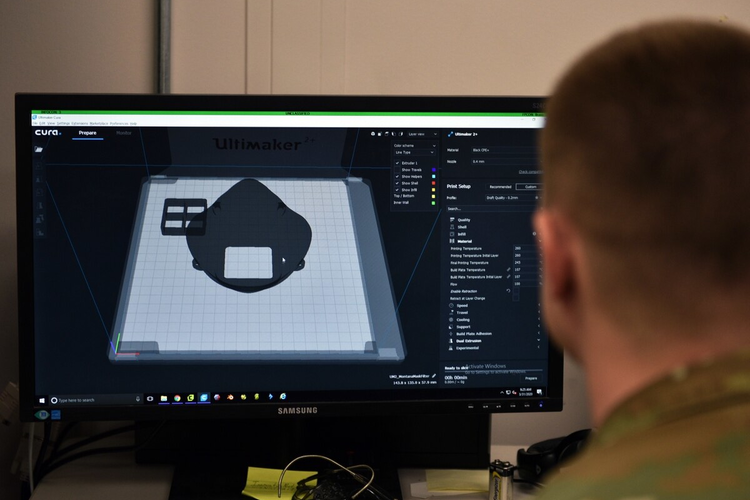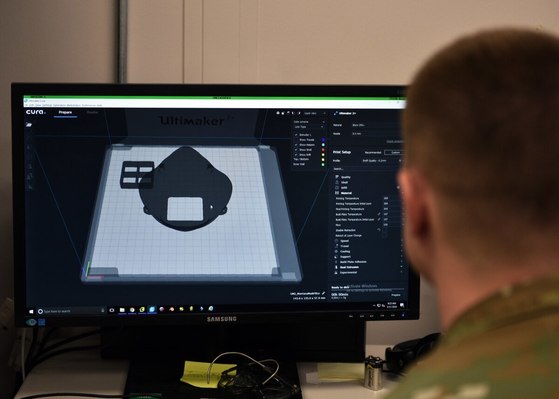Welcome to Thomas Insights — every day, we publish the latest news and analysis to keep our readers up to date on what’s happening in industry. Sign up here to get the day’s top stories delivered straight to your inbox.

In recent years, the adoption of 3D-printing in manufacturing has been fairly slow, with several critics dismissing the technology as inefficient, expensive, and limiting.
But that was before the coronavirus pandemic threw industrial businesses across the globe into disarray, disrupting the supply chains of 94% of Fortune 1000 companies.
Increased demand for medical equipment, supply-chain delays, and factory closures around the world have seen the coronavirus become something of a catalyst for the adoption of 3D-printing.
There are five reasons why the technology is perfectly positioned to meet the supply challenges currently faced:
- Prototyping is quick, making it easy to customize products.
- 3D printers can be easily set up anywhere, which means manufacturers can produce medical equipment close to where it is most needed.
- No tools are needed. A 3D printer only requires raw materials and a digital design.
- A 3D printing facility can be operated by very few people, making it easier to follow social distancing measures and produce products efficiently.
- Industrial-grade medical 3D printers can produce highly precise, strong parts, which are watertight and can withstand being treated with disinfectants and chemicals.
Here are some examples of companies using 3D printing to tackle coronavirus and address the current shortage of medical supplies.
Production of Swabs for Coronavirus Test Kits
Nasopharyngeal swabs are a crucial component of the most commonly used coronavirus test. Made from nylon, foam, or polyester, these swabs need to be long and flexible so they can reach the upper throat and back of the nose.
With a critical undersupply of swabs and an urgent need to ramp up testing to control the spread of the virus, 3D-printers have stepped in. Origin, a 3D-printer manufacturer has dedicated its production to printing 1,500 swabs in eight hours, while a dental college in Georgia is using its seven 3D-printers to produce 5,000 swabs per day.
Replacement Valves for Intensive Care Machinery
Some hospitals are suffering from a critical shortage of ventilators and intensive care machines needed to treat coronavirus patients. Most of this equipment cannot be 3D-printed, but one hospital in Northern Italy discovered a way to 3D-print replacement valves for intensive care machinery.
Meanwhile, Custom Color 3D Printing is using its printers to manufacture a range of components including ventilator replacement valves or splitters, face shields, and stop-gap face masks.
PPE
Throughout the coronavirus crisis, shortages of PPE including face shields, surgical masks, gloves, and aprons have been widely reported. Several organizations are working to combat this using 3D printing.
3D Hubs, which represents the largest network of 3D-printing services in the world, has launched a fund to provide the money and resources needed to produce PPE. To date, the fund has supplied face shields to hospitals in seven countries including the United States.
Ford is working to produce over 100,000 transparent face shields per week while SmileDirectClub, which usually produces 3D-printed invisible braces, have supplied 35,000 face shields within a few weeks.
My Mask Movement is leveraging 3D printing’s aptitude for personalizing products with an iPhone app that can scan a person’s face and build a 3D mask that fits them perfectly – this has been approved for clinical use by the National Institute of Health (NIH).
Quarantine Booths
WinSun 3D, a 3D-printing architecture company based in China, is perhaps best known for its 3D printed toilets. To address the issue of patient crowding and pressure on hospital resources, the company 3D-printed 15 quarantine rooms for the Xianning Central Hospital in Hubei. Made from crushed and ground urban construction waste, the booths come fully equipped with water and electrical supplies.
Door Handle Attachments
Door handles have become one of the most contagious surfaces in hospitals, care homes, and workplaces. To address this, Materialise, a Belgium-based company that provides 3D-printing services, has designed a 3D-printed door opener. Once fitted onto a door handle, users will be able to open it with their arm or elbow to reduce the risk of contamination. The company has shared the design files for the attachment to allow any company or hobbyist with a 3D printer to print the parts themselves.
For those looking to repurpose their manufacturing operations to help the fight against coronavirus, it’s often a case of learning on the go. Organizations, universities, and hobbyists alike must be mindful to follow guidelines and take their time to avoid producing redundant products. The Thomas COVID-19 Resource Hub has an array of 3D-printing templates and designs manufacturers can use to create much-needed medical components.
Image Credit: U.S. Air Force photo by Airman 1st Class Robyn Hunsinger


